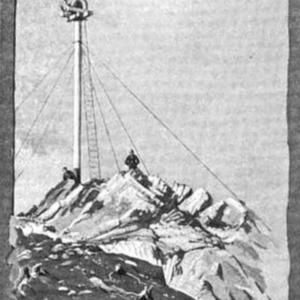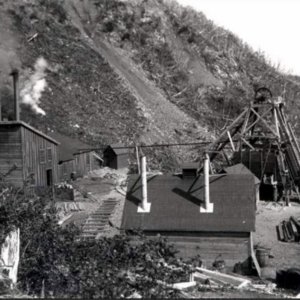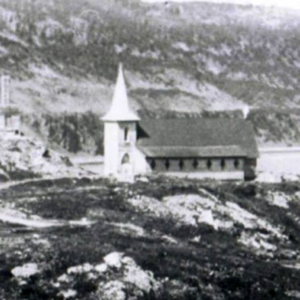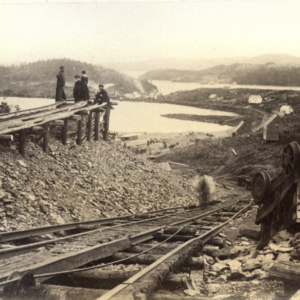 Her Lady of Carmel Parish
Her Lady of Carmel Parish
Her Lady of Carmel Parish stood on this site. Final construction of the church was completed in 1881. The final money to pay for its construction was collected by way of a public performance in St. John’s in 1885. The church had a bell named St. Patrick. It was forged in Little Bay on St. Patrick’s Day in 1889 and likely the work of the blacksmith John Conway. The townsfolk tossed coins from their pockets into the molten metal for the bell which it was said could be heard ringing for miles. The bell was one of the few items to survive the fire which engulfed the town in 1903. It was relocated to the Catholic church in nearby St. Patrick’s where it resides still.
Little Bay was visited by an American artist named Milton James Burns in 1894. It was he who drew the picture of St. Patrick’s belfry you see. If you look to the ground you will further find the rock iron eyebolts which held it. They are all that remain here to mark the place where once Her Lady of Carmel Parish stood overlooking Little Bay.
 Seary Shaft
Seary Shaft
The ore deposit which would become Little Bay mine was uncovered by accident by a hunter named Robert Colbourne in the spring of 1878. Work began on August 15th that year and what was revealed was a great cliff of copper ore. The miners worked on the surface until November that year when the first shaft was sunk for underground work. That first shaft was named Sirius Shaft after the bright star in the night sky. As word of the size and scale of Little Bay’s copper deposit spread across the island Sirius Shaft came to be known near and far by a nickname and henceforth it was called Seary.
 St. Luke’s
St. Luke’s
This was the site of St. Luke’s church of the Church of England. Construction on the church was completed in 1885. In 1888 a steeple was added. The steeple for St. Luke’s was originally part of a Presbyterian church in Betts Cove called Christ’s Church. The hybrid nature of this church was quite unusual for the time and commented on by such notable visitors as Jessie Ohman and Rev. Lumsden.
The town of Little Bay had a reputation for cooperation between the town’s various denominations which was also of note to visitors. Little Bay’s unusual openminded approach could be traced back to Baron Ellershausen and his first appointed clergy Rev. Gunn. Under their leadership the town could claim mixed denominational worship from its very beginning. St. Luke’s with its Presbyterian steeple came to represent that aspect of the town’s culture.
St. Luke’s was lost to fire in 1903.
 Tramway
Tramway
The tramway for Little Bay mine was said to have been strongly built. It was designed by Dr. Henry Eales and in place almost immediately. In fact three quarter miles of tramway connecting the mine site to the loading wharf were on the ground and in operation in September of 1878 when the mine was only one month old. By the end of 1878 over 10,000 tons of ore had traveled that tramway on its way to being loaded onto steamships set for Swansea in Wales. The picture of the tramway you see here was taken by Newfoundland photographer Simeon Parsons during his visit to the region in 1884.
Deaths at the mine (19th century)
George Moores
James Fahey
Nicolas J. Cantwell
Peter Signott
William Garman
Luke Madden
William Maddigan
John Appleton
A man with the last name Young whose first name remains unknown
A man from Little Bay Islands whose whole name remains unknown
